Difference between revisions of "Importing a New Data Source/en"
(Importing a new version from external source) |
(Updating to match new version of source page) |
||
| (71 intermediate revisions by the same user not shown) | |||
| Line 3: | Line 3: | ||
| − | '''This section will show you how to import a new | + | '''This section will show you how to import a new datasource.''' |
See also: | See also: | ||
* [[Importing a New Data Source Tutorial|See a Tutorial]] | * [[Importing a New Data Source Tutorial|See a Tutorial]] | ||
* [[Excel Importing Guide|Excel Importing Guide]] | * [[Excel Importing Guide|Excel Importing Guide]] | ||
| + | * [[CSV Importing Guide|CSV/Text Importing Guide]] | ||
* [[Importing Problems|Check Importing Problems]] | * [[Importing Problems|Check Importing Problems]] | ||
| − | * Download a sample file here: '''[ | + | * [[Import/Update_data|Update Data]] |
| + | * [[Automate_Update_data|Data Update Automation]] | ||
| + | * Download a sample file here: '''[[Special:FilePath/Sales.xlsx|Sales.xlsx]]''' | ||
| − | First select the ''New datasource'' option in the [[Main Page Overview#Menu | + | <span style="color: red;">'''Important:'''</span> Data import is not allowed through tablets and smartphones. |
| + | |||
| + | |||
| + | First select the ''New datasource'' option in the [[Main Page Overview#Menu|Menu]] in the [[Main Page Overview#Datasource Tab|Main Page]]: | ||
| + | |||
| − | [[File:Barra_Lateral+en-US.PNG| | + | [[File:Barra_Lateral+en-US.PNG|link=]] |
| − | + | On the next screen: | |
| − | [[File:Novo_arquivo+en-US.PNG| | + | [[File:Novo_arquivo+en-US.PNG|800px|link=]] |
* '''File''': Choose the file to be imported. Click on the ''Browser'' button to search your computer for files. See [[Supported File Formats]] for more information; | * '''File''': Choose the file to be imported. Click on the ''Browser'' button to search your computer for files. See [[Supported File Formats]] for more information; | ||
| − | * '''Name''': | + | * '''Name''': Datasource name. This is the name that will be displayed on the '''[[Main Page Overview|main page]]'''; |
| − | * '''Description''': An optional description for the new | + | * '''Description''': An optional description for the new datasource. |
| Line 38: | Line 45: | ||
| − | + | On the next screen, you must inform the file specifications: | |
| − | [[File:Formatação dos dados+en-US.PNG| | + | [[File:Formatação dos dados+en-US.PNG|800px|link=]] |
| Line 51: | Line 58: | ||
* '''Delimited by''': Specifies the columns delimiter character. Select between ''Tab'', ''Semicolon'', ''Collon'' or ''Another character'' (for ''Other'' type the desired delimiter in the field). Usually, the correct option is selected automatically. For CSV files only; | * '''Delimited by''': Specifies the columns delimiter character. Select between ''Tab'', ''Semicolon'', ''Collon'' or ''Another character'' (for ''Other'' type the desired delimiter in the field). Usually, the correct option is selected automatically. For CSV files only; | ||
| − | * '''Header''': Check if the file has a ''Header row'' that identifies the columns. The header will be used as the default name for the columns in the | + | * '''Header''': Check if the file has a ''Header row'' that identifies the columns. The header will be used as the default name for the columns in the datasource; |
* '''Decimal Separator''': Specifies the decimal separator used in the file. | * '''Decimal Separator''': Specifies the decimal separator used in the file. | ||
| Line 61: | Line 68: | ||
| − | Notes: | + | '''Notes:''' |
* Is very important to set the right type for each column. When the type is not right, the word NULL will be shown in the cells. | * Is very important to set the right type for each column. When the type is not right, the word NULL will be shown in the cells. | ||
* The Formula columns show the expression used in the spreadsheet or text file. | * The Formula columns show the expression used in the spreadsheet or text file. | ||
| − | + | * You can´t delete existing columns in the datasource. | |
| − | * You can´t delete existing columns in the | ||
* In value columns, empty cells (NULL) will be converted to "0". | * In value columns, empty cells (NULL) will be converted to "0". | ||
* In date columns, empty cells or not valid dates will be converted to NULL. | * In date columns, empty cells or not valid dates will be converted to NULL. | ||
* In text columns, empty cells will be converted to NULL. | * In text columns, empty cells will be converted to NULL. | ||
| + | |||
| + | |||
| + | If you made a sctructure change the header collums apper whit different collors an extra screen will show you the alterations to confirm the changes. | ||
| + | * New columns in the imported file, the header color will be yellow. | ||
| + | * Probably wrong columns the header collor will be red. | ||
| + | |||
| + | '''Attention:''' After you confirm this screen and process the importation you can't undo the changes. | ||
| + | |||
| + | |||
| + | [[File:newfields+en-US.PNG|800px|link=]] | ||
| + | |||
| + | |||
| + | [[File:newfields1+en-US.PNG|800px|link=]] | ||
Click the '''Next''' button to continue. | Click the '''Next''' button to continue. | ||
| − | If you are [[Import/Update data|updating]] a | + | If you are [[Import/Update data|updating]] a datasource, go directly to the [[New Data Source Summary|import summary]]. |
| − | + | On the next screen, you can automatically generate a set of dashboards with your imported data: | |
| − | The process will try to find compatible dashboards with the information you provided | + | The process will try to find compatible dashboards with the information you provided. |
| − | [[File:Colunas geração+en-US.PNG| | + | [[File:Colunas geração+en-US.PNG|800px|link=]] |
| Line 89: | Line 108: | ||
| − | [[File:Resumo importação+en US.PNG| | + | [[File:Resumo importação+en US.PNG|800px|link=]] |
| Line 95: | Line 114: | ||
| − | [[File:progresso_importacao+en-US.PNG| | + | [[File:progresso_importacao+en-US.PNG|800px|link=]] |
| − | + | Wait for TaticView to create/update the required structures and schedule the data import. If everything is ok, click the '''Done!''' button. | |
| − | + | When the datasource import/update is completed, TaticView will automatically update the status on the [[Main_Page_Overview|main page]]. | |
| − | |||
| − | |||
| − | |||
| − | |||
Latest revision as of 02:30, 5 October 2022
This section will show you how to import a new datasource.
See also:
- See a Tutorial
- Excel Importing Guide
- CSV/Text Importing Guide
- Check Importing Problems
- Update Data
- Data Update Automation
- Download a sample file here: Sales.xlsx
Important: Data import is not allowed through tablets and smartphones.
First select the New datasource option in the Menu in the Main Page:
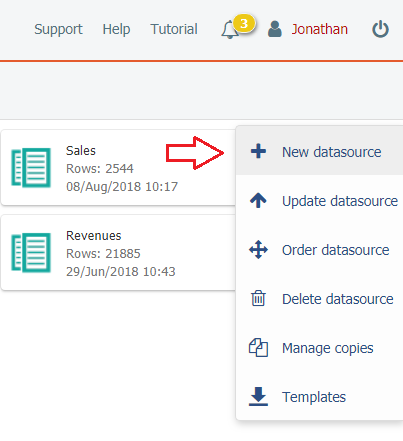
On the next screen:
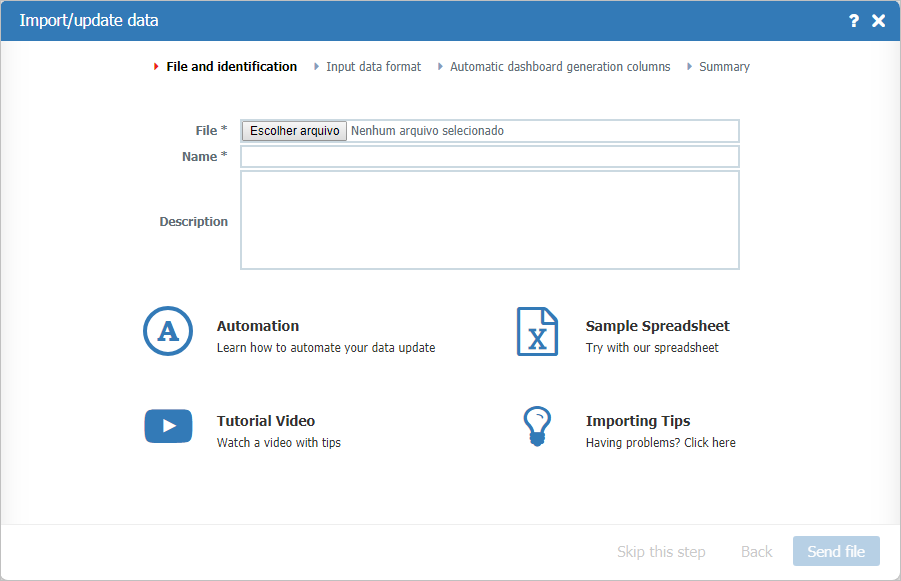
- File: Choose the file to be imported. Click on the Browser button to search your computer for files. See Supported File Formats for more information;
- Name: Datasource name. This is the name that will be displayed on the main page;
- Description: An optional description for the new datasource.
If you have doubts, click on the links "Tutorial Video", "A sample spreadsheet" and other "Importing Tips".
Spreadsheet sample

Click Send File button to continue.
On the next screen, you must inform the file specifications:
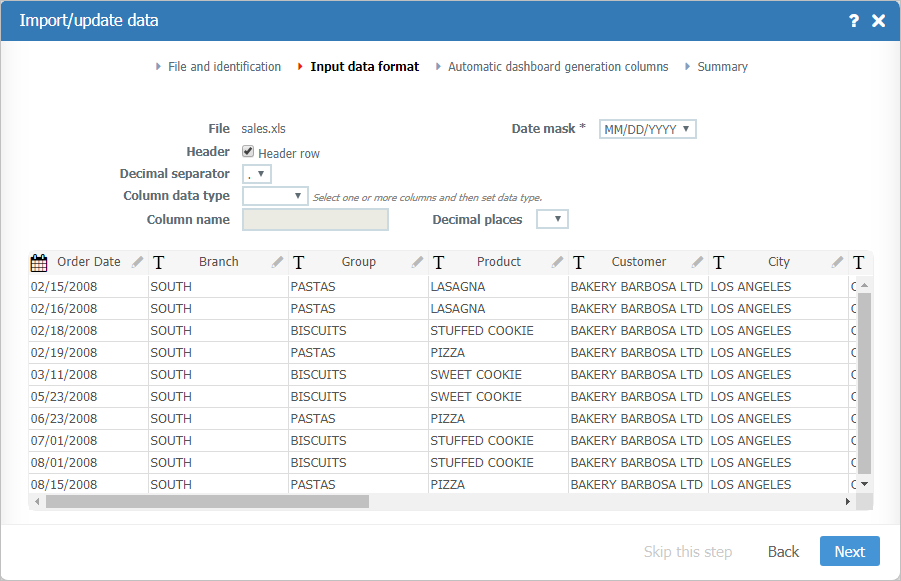
- Charset: Specifies the file charset. Usually, the correct option is automatically selected. For CSV files only;
- Start row: Specifies which row of the file the import process should start reading. Headings should be included if the Header row option is checked. For CSV files only;
- Date mask: Choose the Date fields mask in the file. The selected mask must be exactly equal to the format used by dates in the file.;
- Delimited by: Specifies the columns delimiter character. Select between Tab, Semicolon, Collon or Another character (for Other type the desired delimiter in the field). Usually, the correct option is selected automatically. For CSV files only;
- Header: Check if the file has a Header row that identifies the columns. The header will be used as the default name for the columns in the datasource;
- Decimal Separator: Specifies the decimal separator used in the file.
- Columns options: Click the column header in the preview table to select and change its options:
Notes:
- Is very important to set the right type for each column. When the type is not right, the word NULL will be shown in the cells.
- The Formula columns show the expression used in the spreadsheet or text file.
- You can´t delete existing columns in the datasource.
- In value columns, empty cells (NULL) will be converted to "0".
- In date columns, empty cells or not valid dates will be converted to NULL.
- In text columns, empty cells will be converted to NULL.
If you made a sctructure change the header collums apper whit different collors an extra screen will show you the alterations to confirm the changes.
- New columns in the imported file, the header color will be yellow.
- Probably wrong columns the header collor will be red.
Attention: After you confirm this screen and process the importation you can't undo the changes.
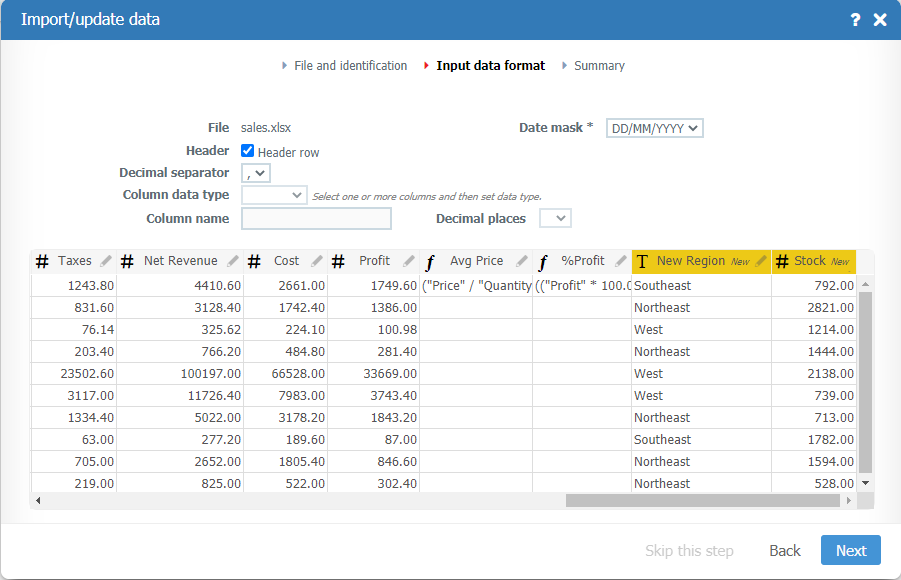
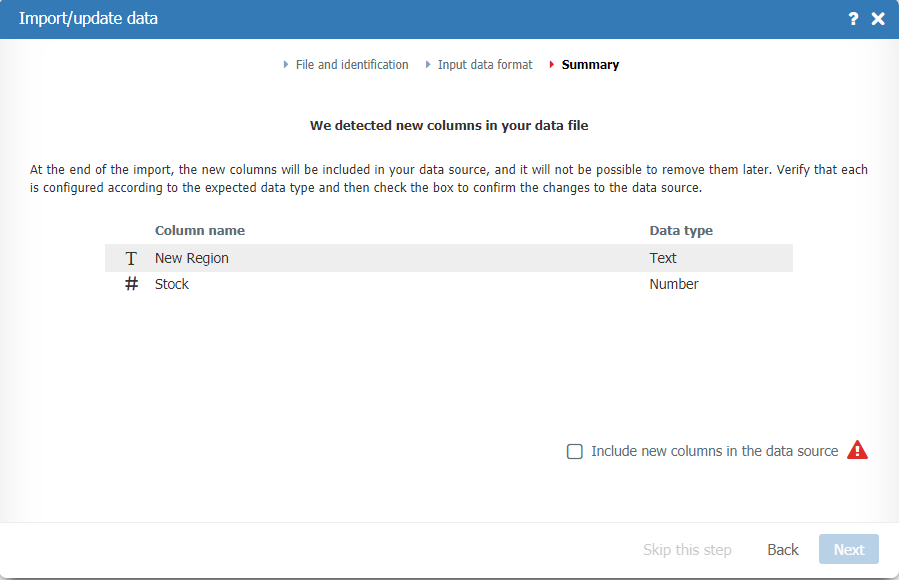
Click the Next button to continue.
If you are updating a datasource, go directly to the import summary.
On the next screen, you can automatically generate a set of dashboards with your imported data:
The process will try to find compatible dashboards with the information you provided.
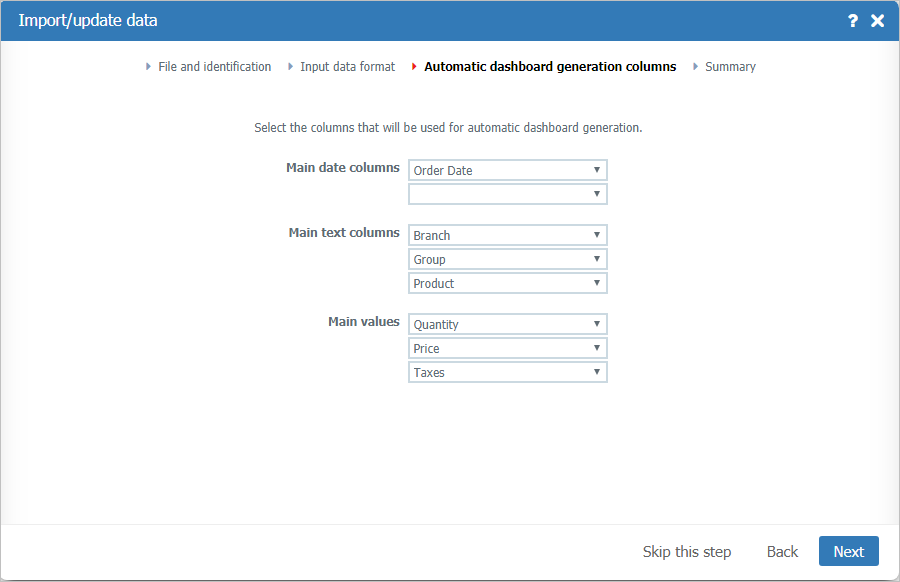
Select the main Date, Text and Value columns that TaticView will use to automatically generate dashboards.
Click the Next button. To skip the automatic dashboards generation, click Skip step. You can do this later. See Generate dashboards.
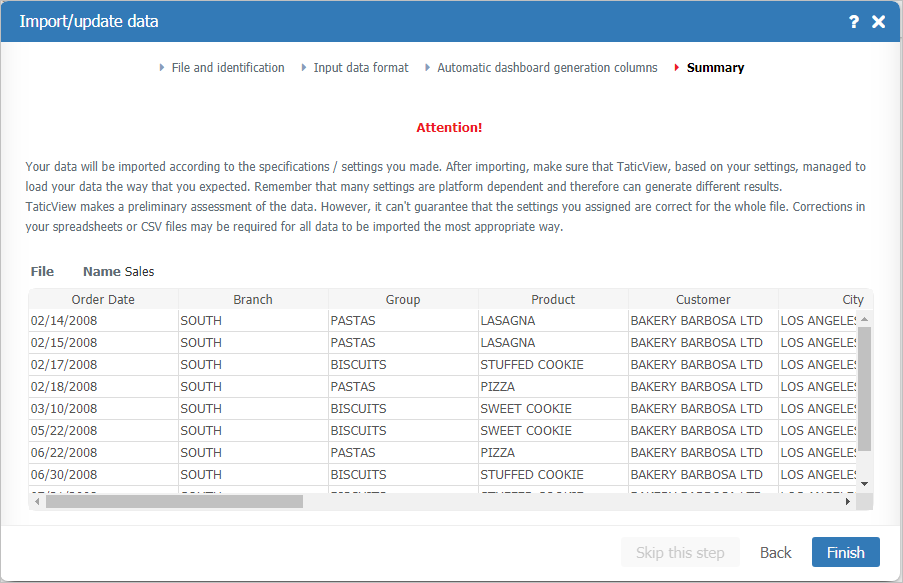
Check the summary information and click the Finish button to complete the operation and schedule the data import.
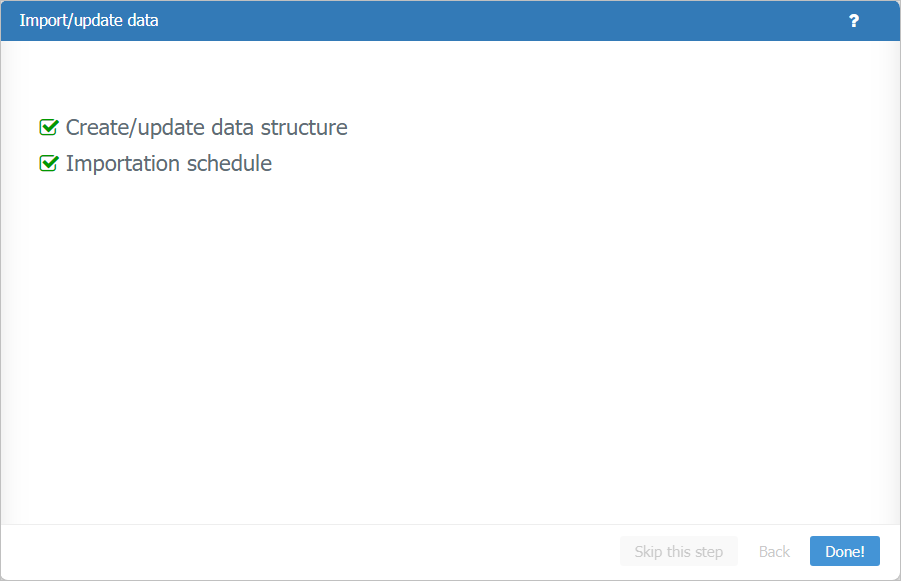
Wait for TaticView to create/update the required structures and schedule the data import. If everything is ok, click the Done! button.
When the datasource import/update is completed, TaticView will automatically update the status on the main page.